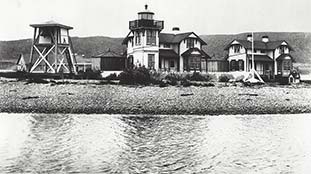New This Week:
Prices in U.S. Dollars are listed in GREEN.
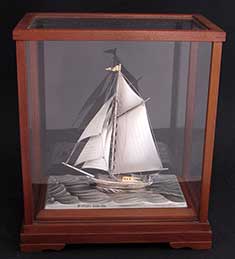 |
|
2.96 SILVER MODEL. Delightful, cased model of a gaff-rigged ketch under full sail plying a wavy sea. The model has all 5 sails set and is flying a pennant from the mast. The mains’l shows mast hoops properly rigged. The solid silver hull shows simulated planking surrounding the cabin and cockpit. The helm is realistically portrayed with a classic ship’s wheel. The hull is marked “STERLING 960.” The entire presentation is housed under 5 panels of clear glass within a handsome rich hardwood frame of pinned construction, The case measures 9 1/8 inches high by 5 inches wide and 8 inches long.. Superb original condition. WAS $895 NOW 295 |
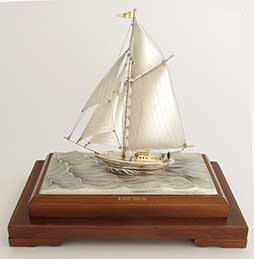 |
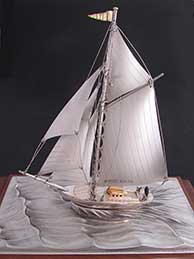 |
| model | yacht |
 |
| sterling |
 |
|
3.62 TELLTALE COMPASS. Third quarter of the 19th century American magnetic compass known as a “telltale” because it allowed the Captain’s to monitor the course steered by the ship’s helmsman. Also known as an “upside down” compass, this arrangement was designed to be hung from the overhead in the Captain’ cabin observable while seated at his desk or his bunk. This pristine example has an engraved paper card back by mica, It is boldly marked with the points of the compass rose down to ½ points and is marked by the Cardinal and Intercardinal points. The north point is designated by a very elaborate fleur-de-lis. The center is signed by the Maker “R. MERRILL’S SONS, NEW-YORK.” The card is supported on a jeweled pivot which is rove through the glass face. It is encompassed by a flared brass flange set into the circular compass body supported in gimbals. Of particular note and value this compass is complete with its original ornate hanging bracket with a decorative floral design. The diminutive compass flange is 5 ½ inches in diameter and 3 5/8 inches in height. With its suspension bracket it is 8 inches wide and stands 6 3/4 inches high when mounted to the overhead. Outstanding original condition in all respects. Fully functional with no flaws. Just about 150 years old. This example is a gem! 1495 |
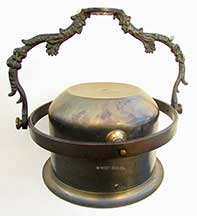 |
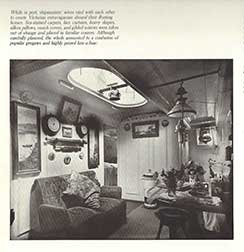 |
| suspended | plate |
 |
|
7.39 REFERENCE BOOK. M.V. Brewington, “The Peabody Museum Collection of Navigating Instruments,” 1963, The Peabody Museum, Salem , Massachusetts. First edition. 145 pages exclusive of index, hard cloth cover, profusely illustrated with black and white photos. Long regarded as the ‘American Bible of Navigational Instruments,’ this landmark work contains detailed information on “Instruments For Location From The Heavens, Instruments of Direction, Instruments of Time, Speed and Distance,” and “Miscellaneous Instruments” such as Dead Reckoning Recorders, Graphic Tools, Sounders, Telescopes, Tide Calculators, Manual Computers, Barometers, Thermometers, Orreries, etc.” A large section is devoted to photographs of representative instruments in the museum’s collection and their detailed descriptions. Further, an extensive portion of the book contains the detailed biographies of early instrument makers, dealers and designers. Initially printed in a limited quantity, this wealth of information was selling for up to $500 in the early days of its publication! It was reprinted in the 1990’s by an authorized outside publisher, selling for $150 a copy. This is a prized ORIGINAL 1st edition! MINT, as new condition. 99 |
 |
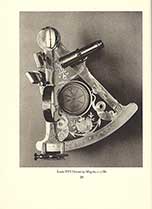 |
| title page | plate 1 |
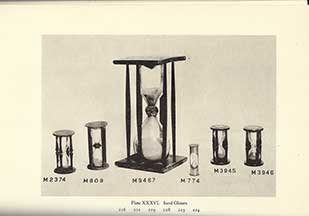 |
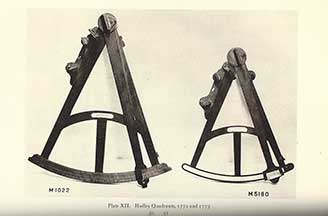 |
| plate 2 | plate 3 |
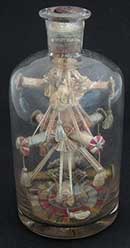 |
|
16.46 P.O.W. BOTTLE WHIMSEY. Extraordinarily rare bottle folk art as produced by French Prisoners in British prisons during the Napoleonic Wars 1795 – 1805. This amazing example is contained in a clear hand-blown glass bottle with telling pontil on its thick base. It contains a very complex wooden structure comprised of 12 radiating arms in 3 tiers. Each of the arms is tightly decorated in wrapped silk thread providing a shimmering appearance. At the end of each arm is a multi-faceted radiating silk disc. What’s more, every arm supports suspended silk tassels on their ends. Further complicating the display, there are radiating silk sprays at the juncture of each of the arms. But if that wasn’t enough to showcase the maker’s skills, he embellished the bottom of the bottle with a fabulous array of woven silk segments radiating from the center in a variety of contrasting colors. (Please see the photo). The undisturbed original cork stopper is in place under the original sealing wax. The neck contains an “mystery” comma-shaped cross brace with suspended brass “tear drips.” The bottle measures 6 ¾ inches tall and 3 ¼ inches in diameter. The bottle and its contents are in exceptional original condition after more than two and one quarter centuries! Without question museum-quality. Offered here at an absolutely bargain price. Easily a $1,500 value. NOW 495 |
 |
 |
| side | top |
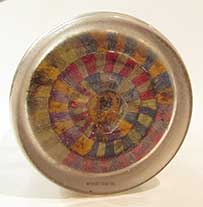 |
| bottom pontil |

|
detail |
open |
left perspective |
right perspective |
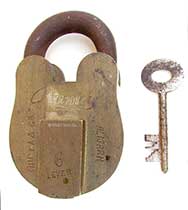 |
16.42 PADLOCK. Massive vintage padlock. This industrial quality portable lock is made of solid brass with a thick steel shackle. The side is engraved “Rama, Gupta & Co., ALIGARH.” The key hole has a thick sliding cover marked “6 LEVER.” Complete with its original skeleton key, the lock opens, closes and securely locks properly. 5 inches long, 3 inches wide by 1 5/8 inches thick and weighs an impressive 2 ½ pounds! 150 The R.N. Gupta Co., Ltd. was founded in India in 1948. They were, and still are producers of heavy equipment, steel forging and general engineering. |
 |
 |
| detail | open |
 |
| back |

|
AUTHENTIC LIGHTHOUSE. The ultimate! This was an exceptional opportunity to own a very historic relic of America’s rich maritime heritage embodied in the original lamp room from the famous Ballast Point Lighthouse, which served its sentinel duties in the channel of San Diego Bay from 1890 until 1960. This incredibly well-preserved piece of history was built according to specifications laid out by the U.S. Lighthouse Service in 1885. A copy of the original specifications are included as are much printed references and photographs. Erected in 1890, the 5th Order lighthouse was a significant aid to navigation in conjunction with the Point Loma Lighthouse (1850) poised at the entrance to San Diego Bay. Ballast Point Light was situated further inside the massive bay on a point which jutted into the seaway which posed a hazard to shipping. 135 years old! SOLD HISTORY On October 2, 1888, recognizing the need for a harbor light in the increasingly congested channel of San Diego Bay, Congress authorized $25,000 for the construction of a lighthouse to be built on Ballast Point. Fashioned in the late Victorian style, the entire structure took 3 months to build beginning in March 1890. The light was first lit on August 1st. It was a sister of the lights at San Luis Obispo and Table Bluff, south of Humboldt Bay. All were wood framed structures with attached living quarters. The ironwork for the lantern was forged in San Francisco and carried south to San Diego by ship. The French firm of Sautter, Lemmonier, & Cie. manufactured the Freznel lens for the Ballast Point Light in 1886. The fixed 5th Order lens was visible for a distance of at least 11 miles. When California was still part of Mexico the peninsula jutting into San Diego Bay was known as Punta del los Guijarros or “Pebble Point.” For centuries cobblestones washed down by the San Diego River had been deposited on the point. When California gained statehood in 1850 the point was renamed Middle Ground Shoal. As time went on and merchant traffic in the harbor increased, many sailing ships found it convenient to load or discharge the stones as ballast. The practice continued and eventually the name “Ballast Point” stuck. Accompanying the Ballast Point lighthouse was a huge 2,000 pound fog bell in a wooden tower. In 1928 it was supplanted by a single tone electric diaphone horn. The first keeper of the light was John M. Nilsson, assigned duty on July 15, 1890. The second was Henry Hall, who took the job on December 1, 1892. Perhaps the most famous keeper was Irish born David R. Splaine, a Civil War veteran and veteran lighthouse keeper, who assumed the post in 1894, having served at Point Conception, the Farallons and San Diego’s own Point Loma light from 1886-1889. In 1913 the original old kerosene lamp was replaced with an acetylene burner. Acetylene gave way to electricity in 1928. In 1938 a filter was fitted inside the 5th Order Freznel lens giving the light a distinctive green hue for recognition. One of the last keepers of the light was Radford Franke who recalled receiving the order to “douse the light” upon the news of the attack on Pearl Harbor. By early 1960 the light was deemed to be of no further service, so in June of that year the lantern room was removed to a salvage yard. The wooden tower and its brick and mortar foundation remained a couple of years later until they too were declared structurally unsafe and demolished. The bell tower continued to survive, mounted with a 375 mm high intensity lamp on its roof. However the value of maintaining any light on Ballast Point diminished with the installation of harbor entrance range lights. In the late 1960’s the bell and its tower were dismantled. The tower found its way to a private residence in Lakeside, California. The bell had a more circuitous later life. It was purchased from a San Diego area junk yard in 1969 for its scrap value of 5 cents per pound! The one ton bell remained on local private property until 1991, when it was put on loan to the San Diego Maritime Museum. In 1999 the bell was transported to the son of the original buyer, living in Colorado. Then in 2002, the bell finally found its way to the home of the owner’s granddaughter living in Vermont, where it rests to this day. The story of the lantern’s later life is even more fascinating. The nation was just recovering from the Cuban Missile Crisis between JFK and Khrushchev, when in 1964 the Cuban government cut off the fresh water supply to the U.S. Naval base at Guantanamo Bay. By that time, an experimental desalinization plant had been in operation at Point Loma for 2 years. The Navy hastily ordered it to be disassembled and shipped through the Panama Canal to Cuba. A gentleman working as a crane operator during the process noted the shabby lantern room in a trash heap nearby. He inquired as to the fate of the relic and was told it was salvage. Asking if he could purchase it, the yard foreman told him he could “have it” if he would haul it away. With that, for the next 34 years the lantern room served as a gazebo in the backyard of the man’s residence in Bonita, California. It was purchased by the present owners in 1998, fully refurbished, and then placed on public display ever since. Now it is time for it to find its next new home. According to the crane operator who delivered the lamp room it weighs approximately 5 tons. It will require a crane and a flat bed truck for removal. BIBLIOGRAPHY F. Ross Holland, “The Old Point Loma Lighthouse,” 1978, Cabrillo Historical Association, San Diego, California Jim Gibbs, “The Twilight of Lighthouses,” 1996, Schiffer Publishing, Atglen, PA. Kin Fahlen and Karen Scanlon, “Lighthouse of San Diego,” 2008, Arcadia Publishing, San Francisco Kraig Anderson, “Forgotten Ballast Point “Lighthouse” Seeks New Home,” article in “Lighthouse Digest,” East Machias, Maine, September – October 2011, Vol. XX, no. 5 pages 34 – 37. “Mains’l Haul,” a periodic publication of the San Diego Maritime Association, Summer 1990, Vol. XXVI, No. 4, pp. 11-12. |
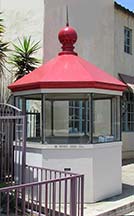 |
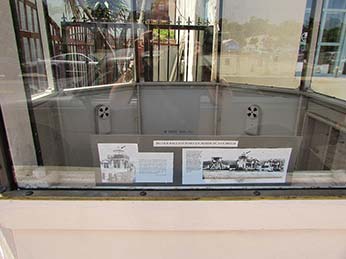 |
| LIGHTHOUSE BACK | DETAIL BRASS WINDOW MOLDINGS AND GLASS |
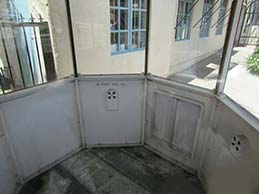 |
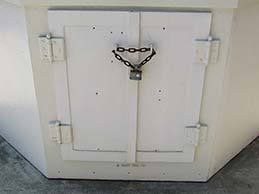 |
| INTERIOR | ENTRY DOORS. THERE WAS NO INTERNAL ACCESS TO THE LAMP ROOM |
 |
 |
| THE LIGHTHOUSE COMPLEX AS IT APPEARED IN THE 1940'S | DISMANTLING THE LANTERN ROOM IN 1960 |
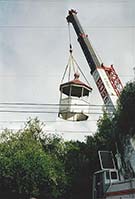 |
| LIGHTHOUSE GINGERLY BEING REMOVED OVER HIGH TENSION POWER LINES |































